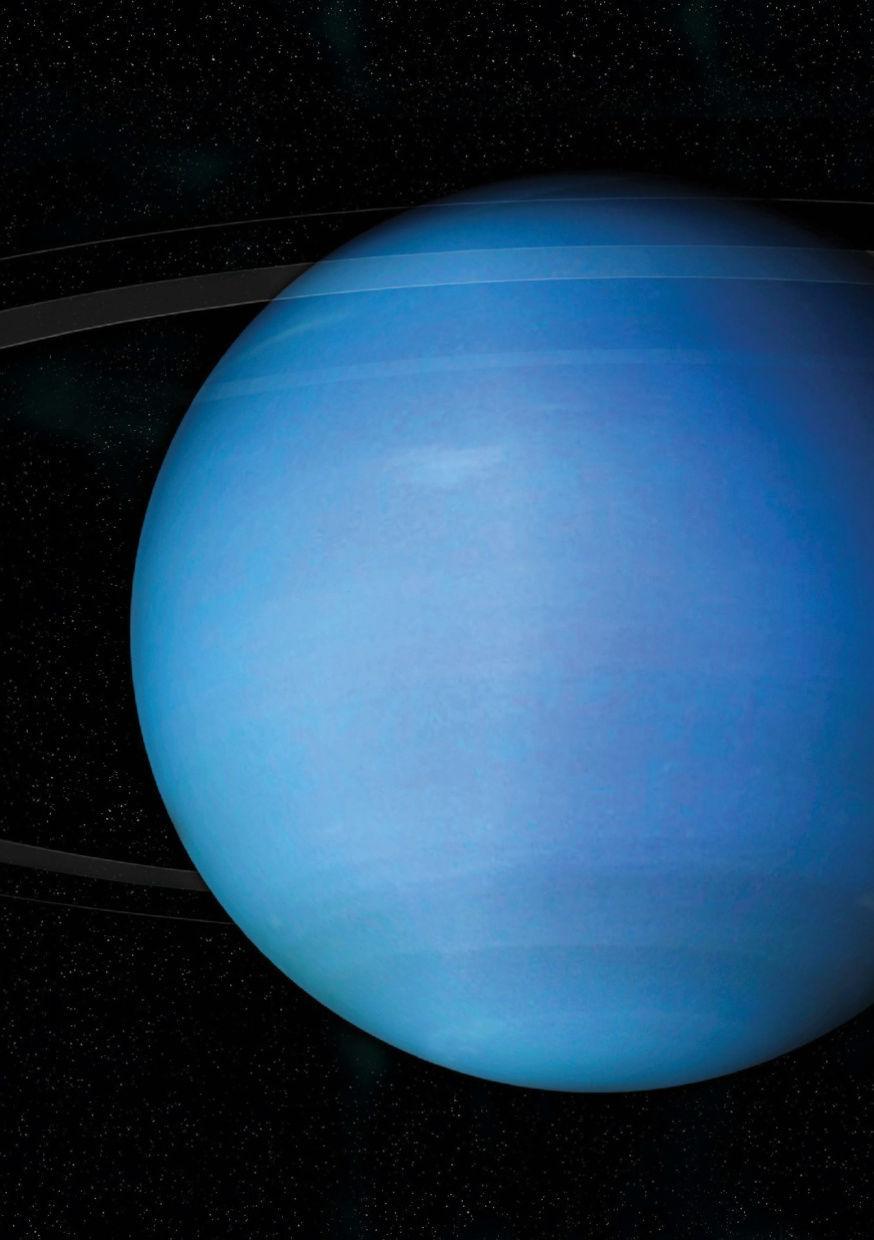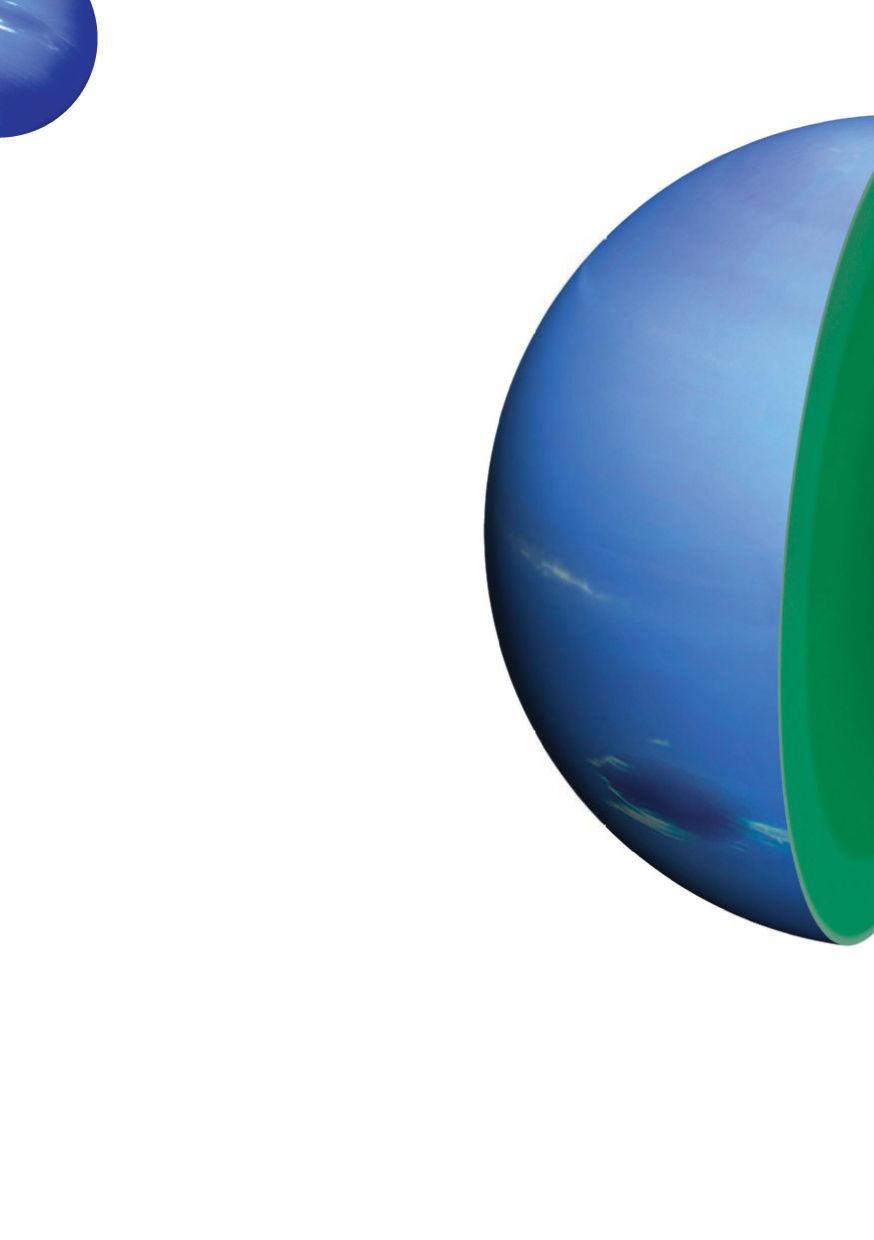
9 minute read
Uranus
from Oldie
by maurice.2008
Uranus inside and out
It has a very similar structure to Neptune but this ice giant still retains its mysteries
Advertisement
The term ‘gas giant’ implies that Uranus is solely composed of gases, but studies indicate that it actually has a core of silicate rock, encased in ices and topped with a gaseous layer. The core must be very small, since Uranus is the second-least dense planet. It likely takes up only 20 per cent of the planet’s radius. The ice mantle surrounding the core is fluid, with volatiles like methane, ammonia and water. In fact, this electrically conducive fluid is often called an ammoniawater ocean by experts. The outer layer is mostly helium and hydrogen.
Uranus is also much cooler inside than the other gas giants – it’s actually the coldest planet in the Solar System. Neptune radiates 2.61 times the heat that Uranus does. We aren’t sure why Uranus is so cold in comparison, but it may have been struck by a large body that forced it to expel most of the heat it had when formed, or there could be a complex system at work in the atmosphere that keeps core heat from getting out.
The atmosphere contains three layers: the thermosphere, the stratosphere and the troposphere. The lowest layer, the troposphere, is the most interesting and is rich in volatile ices like methane and ammonia. It has four cloud layers: methane, hydrogen sulphide and ammonia, ammonium hydrosulphide, and water clouds at the upper limit. We’ve only observed the top two layers, along with a hazy layer above them. The stratosphere sits between the troposphere and the outermost layer, the thermosphere. Uranus tends to look light bluish or greenish in colour, and it has faint darker bands. The overall colour is due to the way that
methane absorbs visible and nearinfrared light.
Until Voyager 2 explored Uranus’s atmosphere, we didn’t know much about its features. The probe found a bright polar cap at the south pole, as well as a lighter band called a collar. There were darker bands in the southern hemisphere and about ten lighter clouds around the middle latitudes. The timing of Voyager 2’s arrival meant that it could not fully observe the northern hemisphere. In the Nineties, Hubble and groundbased telescopes like the Keck Observatory began to see more atmospheric features on Uranus. They spotted many more clouds in the northern hemisphere, which are brighter and at a higher elevation than the ones in the southern hemisphere. They also observed in 2007 that the southern collar had nearly disappeared, while one in the north had grown.
Clouds Its cloud layers include water, ammonium hydrosulphide, ammonia, hydrogen sulphide and methane

Atmosphere The outer gaseous layer of Uranus is mostly hydrogen and helium
Mantle Uranus’s mantle is icy but fluid, and includes water, methane and ammonium
Uranus in numbers Fantastic figures and surprising statistics about the distant planet
Uranus is the coldest planet: its average temperature is around -197°C (-322°F) -197°C
Wind speeds on Uranus can reach 250 metres per second (900km/h, 560mph) 9 years The number of years it took Voyager 2 to reach Uranus after launching from Earth. Voyager 2 is still going strong after 35 years 900 km/h It takes Uranus 84 years to complete its orbit around the Sun 84 years
40kg What you would weigh on Uranus if you weigh 45kg (100lb) on Earth
8.69 m / s 2 The acceleration due to gravity on Uranus, compared to 9.8m/s 2 on Earth
Uranus’s volume is more than 60 times that of Earth 60x

NEPTUNE

A frozen world on the outermost limits of our Solar System, Neptune is a mysterious planet with its own unique characteristics
This image of the planet Neptune, seen as a small blue disc in the centre, was taken from the Earth in 1998 using a camera fitted to a telescope
Neptune’s claim to fame is being the first planet discovered not by observation, but by prediction. French astronomer Alexis Bouvard closely observed the orbit of Uranus, and detected a gravitational perturbation that he deduced could only be explained by another planet. From his observations, other astronomers calculated the location of Neptune. Galileo actually spotted Neptune 200 years before, but thought it was a star.
There’s still some debate over who did deserve the credit – French astronomer Urbain Le Verrier or British astronomer John Couch Adams, or a third astronomer, Johann Galle. Galle was the first to look at Neptune and understand what it was, using calculations from Le Verrier, on 23 September 1846. He discovered Neptune’s largest moon, Triton, shortly after. Given the distance – 4.3 billion km (2.7 billion mi) – Neptune is not visible to the naked eye. Until powerful modern telescopes and the invention of the Hubble Space Telescope, it was difficult to study Neptune.
Neptune is the third-largest planet by mass, and 17 times the mass of Earth. It’s also the fourth-largest planet by diameter. As the eighth planet from the Sun, Neptune was the furthest known planet until Pluto was discovered in

1930. Although it’s back to being the outermost planet since Pluto’s demotion, Neptune was still occasionally the outermost planet before, as Pluto’s eccentric orbit caused it to cross inside Neptune’s orbit. It’s one of the four gas giants, and is also called Uranus’s ‘twin’. Because they’re very similar in composition, both planets are often known as ice giants to distinguish them from Jupiter and Saturn. They’re mostly made up of hydrogen and helium, with ices of water, methane, and ammonia, surrounding an icy rock core. While the methane content results in Uranus having a blue-green colour, Neptune is a brighter blue. Neptune also has an extremely cold atmosphere like Uranus, topping out at about -218°C (-360°F) in the upper levels.
Although Neptune doesn’t have the extreme horizontal tilt of Uranus, its magnetosphere is strongly tilted away from its rotational axis, at 47 degrees. Neptune also has a ring system and more than a dozen known moons. But whereas Uranus has a relatively dull atmosphere, a lot happens weather-wise on Neptune. When Voyager 2 flew by in 1989 (the only spacecraft to do so), it observed lots of interesting weather. This includes some of the fastest winds in the Solar System, at around 2,000 km/h (1,240 mph).
Neptune’s blue appearance is believed to be caused partly by the methane in its outermost regions
Orbit and tilt

Orbit
It takes around 164 years for Neptune to complete one orbit around the Sun
Neptune is 3.9 times bigger than the Earth by diameter, and you could fit 57 Earths inside one Neptune
Rotation The planet completes one rotation in 16 hours. This varies as different aspects of its atmosphere rotate at slightly different speeds
Neptune’s tilt is much like Earth’s at 28.32 degrees, so it has regular seasons, which happen to last about 40 years, because at 4.50 billion kilometres (2.8 billion miles) from the Sun, it has an orbit of 164.79 years. That means that in 2011, it completed its first orbit since it was discovered.
Tilt Neptune has an axial tilt that's very similar to that of Earth’s at 28.32 degrees
Neptune’s gravitational pull also has an impact on the Kuiper belt, a large ring of tiny, icy objects – including the dwarf planet, Pluto. Neptune’s gravity has destabilised areas of the belt, and it has also created a resonance between the planet and at least 200 of the objects.
Neptune is a bright blue, warm and experiences active weather Neptune inside and out
Like Uranus, Neptune is a gas giant but not solely comprising gases. Its core contains silicate rock, iron and nickel and is a little larger than planet Earth. Neptune’s core is also under great pressure (twice as much pressure as the Earth’s core) and about 5,100 °C (9,200 °F). The mantle surrounding the core is icy, but that’s a relative term when it comes to planet temperatures because it’s actually a hot, dense liquid. Made of methane, ammonia, and water, the mantle is electrically conductive and its temperature ranges between 1,700 °C (3,100 °F) and 4,700 °C (8,500 °F). The mantle may also consist of additional layers, including a layer of ionised water (with electrically charged hydrogen and oxygen) and a deeper layer of superionised water.
Neptune’s atmosphere surrounding the mantle is about 80 per cent hydrogen, 19 per cent helium, and the rest traces of ammonia, water and methane. The methane, which absorbs red light in the spectrum, gives Neptune its colour. Since the atmospheric composition is supposed to be very similar to that of Uranus’s, there must be something else in the atmosphere that makes Neptune a bright blue versus Uranus’s bluishgreen. It has two main divisions – the troposphere and the stratosphere. The troposphere probably has several different types of cloud bands, depending on where they’re located. The lowest levels are clouds of hydrogen sulphide and ammonia. Then there are water ice clouds as the temperature drops, at a pressure of 50 bars. A cloud layer of water, hydrogen sulphide, ammonia and ammonium sulphide floats above five bars of pressure. Between one and five bars, in the uppermost layer of the troposphere, the clouds

are made up out of ammonia and hydrogen sulphide. Bands of these clouds are wrapped around the whole planet, casting shadows on opaque clouds below them.
Neptune is warmer overall than Uranus. Its stratosphere has traces of carbon monoxide, and the thermosphere is unusually very warm at a high 480°C (900°F) given Neptune’s distance from the Sun. The planet radiates more than twice the energy of Uranus and receives only 40 per cent of the sunlight of its twin, yet has about the same surface temperature. We aren’t sure why, but these differences in heat may be why Neptune has weather like storms and high winds, while Uranus does not.
Neptune has storms, including hurricane-force winds that constantly blow around the planet
Core
Mantle Core Neptune has quite a small rocky core of iron, nickel and silicates

Mantle The icy fluid mantle comprises ammonia, water, and methane
Atmosphere The layered atmosphere of Neptune is mostly hydrogen, and with different cloud compositions depending on their elevation
Supersonic winds and storms
Neptune’s massive winds and storms set it apart from Uranus. Most of the winds blow in retrograde rotation (opposite the planet’s rotation), but the general pattern is prograde rotation (in the direction of the planet) in the higher latitudes and retrograde rotation in the lower latitudes. The winds reach almost 2,000 kilometres per hour (1,240 miles per hour) – nearly supersonic speeds.
On Voyager 2’s flyby in 1989, it observed a massive anti-cyclonic storm that was 13,000 by 6,600 kilometres (8,700 by 4,100 miles) in size. The storm was dubbed the Great Dark Spot. It wasn’t present when the Hubble Space Telescope viewed the planet five years later, but another storm was found and given the name. Neptune also has other large storms named the Scooter and the Small Dark Spot.
Special processing of this Neptune image taken by Voyager 2 shows the variations in temperature in its atmosphere






